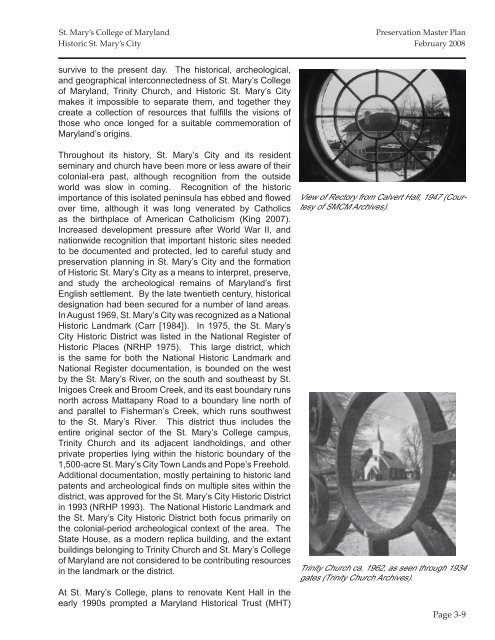St. Mary's College of Maryland Preservation Master Plan
St. Mary's College of Maryland Preservation Master Plan
St. Mary's College of Maryland Preservation Master Plan
- No tags were found...
Create successful ePaper yourself
Turn your PDF publications into a flip-book with our unique Google optimized e-Paper software.
<strong>St</strong>. Mary’s <strong>College</strong> <strong>of</strong> <strong>Maryland</strong><strong>Preservation</strong> <strong>Master</strong> <strong>Plan</strong>Historic <strong>St</strong>. Mary’s City February 2008survive to the present day. The historical, archeological,and geographical interconnectedness <strong>of</strong> <strong>St</strong>. Mary’s <strong>College</strong><strong>of</strong> <strong>Maryland</strong>, Trinity Church, and Historic <strong>St</strong>. Mary’s Citymakes it impossible to separate them, and together theycreate a collection <strong>of</strong> resources that fulfills the visions <strong>of</strong>those who once longed for a suitable commemoration <strong>of</strong><strong>Maryland</strong>’s origins.Throughout its history, <strong>St</strong>. Mary’s City and its residentseminary and church have been more or less aware <strong>of</strong> theircolonial-era past, although recognition from the outsideworld was slow in coming. Recognition <strong>of</strong> the historicimportance <strong>of</strong> this isolated peninsula has ebbed and flowedover time, although it was long venerated by Catholicsas the birthplace <strong>of</strong> American Catholicism (King 2007).Increased development pressure after World War II, andnationwide recognition that important historic sites neededto be documented and protected, led to careful study andpreservation planning in <strong>St</strong>. Mary’s City and the formation<strong>of</strong> Historic <strong>St</strong>. Mary’s City as a means to interpret, preserve,and study the archeological remains <strong>of</strong> <strong>Maryland</strong>’s firstEnglish settlement. By the late twentieth century, historicaldesignation had been secured for a number <strong>of</strong> land areas.In August 1969, <strong>St</strong>. Mary’s City was recognized as a NationalHistoric Landmark (Carr [1984]). In 1975, the <strong>St</strong>. Mary’sCity Historic District was listed in the National Register <strong>of</strong>Historic Places (NRHP 1975). This large district, whichis the same for both the National Historic Landmark andNational Register documentation, is bounded on the westby the <strong>St</strong>. Mary’s River, on the south and southeast by <strong>St</strong>.Inigoes Creek and Broom Creek, and its east boundary runsnorth across Mattapany Road to a boundary line north <strong>of</strong>and parallel to Fisherman’s Creek, which runs southwestto the <strong>St</strong>. Mary’s River. This district thus includes theentire original sector <strong>of</strong> the <strong>St</strong>. Mary’s <strong>College</strong> campus,Trinity Church and its adjacent landholdings, and otherprivate properties lying within the historic boundary <strong>of</strong> the1,500-acre <strong>St</strong>. Mary’s City Town Lands and Pope’s Freehold.Additional documentation, mostly pertaining to historic landpatents and archeological finds on multiple sites within thedistrict, was approved for the <strong>St</strong>. Mary’s City Historic Districtin 1993 (NRHP 1993). The National Historic Landmark andthe <strong>St</strong>. Mary’s City Historic District both focus primarily onthe colonial-period archeological context <strong>of</strong> the area. The<strong>St</strong>ate House, as a modern replica building, and the extantbuildings belonging to Trinity Church and <strong>St</strong>. Mary’s <strong>College</strong><strong>of</strong> <strong>Maryland</strong> are not considered to be contributing resourcesin the landmark or the district.At <strong>St</strong>. Mary’s <strong>College</strong>, plans to renovate Kent Hall in theearly 1990s prompted a <strong>Maryland</strong> Historical Trust (MHT)View <strong>of</strong> Rectory from Calvert Hall, 1947 (Courtesy<strong>of</strong> SMCM Archives).Trinity Church ca. 1962, as seen through 1934gates (Trinity Church Archives).Page 3-9
















